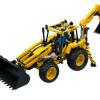
42042 - Crawler Crane - Mods and improvements
By
kolbjha, in LEGO Technic, Mindstorms, Model Team and Scale Modeling
-
Recently Browsing 0 members
No registered users viewing this page.

By
kolbjha, in LEGO Technic, Mindstorms, Model Team and Scale Modeling
No registered users viewing this page.